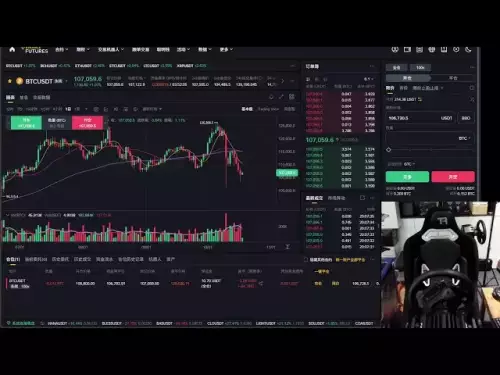-
 bitcoin
bitcoin $106975.071866 USD
-0.29% -
 ethereum
ethereum $3871.670850 USD
-0.07% -
 tether
tether $1.000261 USD
-0.01% -
 bnb
bnb $1084.417621 USD
-0.50% -
 xrp
xrp $2.348167 USD
0.82% -
 solana
solana $185.621736 USD
0.45% -
 usd-coin
usd-coin $0.999833 USD
-0.04% -
 tron
tron $0.313423 USD
0.81% -
 dogecoin
dogecoin $0.188856 USD
0.54% -
 cardano
cardano $0.630416 USD
-0.49% -
 hyperliquid
hyperliquid $36.506353 USD
2.24% -
 ethena-usde
ethena-usde $0.999584 USD
-0.01% -
 chainlink
chainlink $16.750026 USD
-0.77% -
 stellar
stellar $0.313373 USD
0.37% -
 bitcoin-cash
bitcoin-cash $465.978560 USD
-1.57%
How to deal with slippage in APT transactions? What are the ways to reduce trading losses?
To minimize slippage in APT transactions, use limit orders, trade during high liquidity periods, split large orders, and monitor market depth.
Apr 30, 2025 at 07:36 am

Dealing with slippage in APT (Aptos) transactions and reducing trading losses are crucial aspects of trading in the cryptocurrency market. Slippage occurs when there is a difference between the expected price of a trade and the price at which the trade is executed. This can lead to unexpected losses, especially in volatile markets. In this article, we will explore various strategies to manage slippage and minimize trading losses when dealing with APT transactions.
Understanding Slippage in APT Transactions
Slippage in the context of APT transactions refers to the difference between the price at which a trader expects to execute a trade and the actual price at which the trade is executed. This discrepancy can occur due to several factors, including market volatility, liquidity, and the size of the order. For instance, if you place a market order to buy APT at a certain price, but the market moves before your order is filled, you might end up buying at a higher price, resulting in slippage.
To better understand slippage, consider the following scenarios:
- High Volatility: During periods of high market volatility, prices can change rapidly, increasing the likelihood of slippage.
- Low Liquidity: If the APT market has low liquidity, large orders can significantly impact the price, leading to slippage.
- Order Size: Larger orders are more likely to experience slippage because they require more liquidity to be filled.
Strategies to Minimize Slippage in APT Transactions
To minimize slippage in APT transactions, traders can employ several strategies. Here are some effective methods:
Use Limit Orders: Instead of using market orders, which are executed at the best available price, use limit orders. A limit order allows you to specify the maximum price you are willing to pay for APT. This can help you avoid buying at a higher price than expected.
Trade During High Liquidity Periods: Trading when the market has high liquidity can reduce the impact of your order on the price. Typically, liquidity is higher during the overlap of major market hours, such as when both the Asian and European markets are open.
Split Large Orders: If you need to execute a large order, consider splitting it into smaller orders. This can help minimize the impact on the market price and reduce slippage.
Monitor Market Depth: Before placing an order, check the order book to understand the market depth. This can give you an idea of the liquidity available at different price levels and help you set more realistic expectations for your trade.
Reducing Trading Losses in APT Transactions
In addition to managing slippage, reducing overall trading losses is essential for successful trading in APT. Here are some strategies to help you minimize losses:
Set Stop-Loss Orders: A stop-loss order can help limit your losses by automatically selling your APT if the price drops to a certain level. This can prevent a small loss from turning into a significant one.
Diversify Your Portfolio: Diversification can help spread risk across different assets. Instead of putting all your funds into APT, consider investing in a variety of cryptocurrencies to reduce the impact of any single asset's performance on your overall portfolio.
Stay Informed: Keeping up-to-date with market news and trends can help you make more informed trading decisions. Understanding the factors that influence APT's price can help you anticipate market movements and adjust your strategy accordingly.
Use Technical Analysis: Technical analysis can help you identify potential entry and exit points for your trades. By analyzing price charts and indicators, you can make more precise predictions about APT's future price movements.
Practical Steps to Implement These Strategies
Implementing the strategies mentioned above requires careful planning and execution. Here are some practical steps to help you apply these strategies effectively:
Setting Up Limit Orders:
- Open your trading platform and navigate to the APT trading pair.
- Select the option to place a limit order.
- Enter the quantity of APT you want to buy or sell.
- Set the limit price at which you want the order to be executed.
- Review your order details and submit the order.
Splitting Large Orders:
- Determine the total quantity of APT you want to trade.
- Divide the total quantity into smaller, manageable chunks.
- Place multiple limit orders at different price levels to spread out the impact on the market.
Setting Up Stop-Loss Orders:
- Open your trading platform and navigate to the APT trading pair.
- Select the option to place a stop-loss order.
- Enter the quantity of APT you want to protect.
- Set the stop price at which you want the order to be triggered.
- Review your order details and submit the order.
Monitoring Market Depth:
- Open your trading platform and navigate to the APT trading pair.
- Look for the order book or market depth chart.
- Analyze the available liquidity at different price levels to understand the potential impact of your order.
Tools and Resources for APT Trading
To effectively manage slippage and reduce trading losses, it's important to use the right tools and resources. Here are some recommendations:
Trading Platforms: Choose a reputable trading platform that offers advanced order types, such as limit and stop-loss orders. Platforms like Binance, Coinbase, and KuCoin are popular choices for trading APT.
Technical Analysis Tools: Use tools like TradingView or MetaTrader to analyze APT's price charts and indicators. These tools can help you identify trends and potential entry and exit points.
News and Analysis Websites: Stay informed about the latest developments in the cryptocurrency market by following websites like CoinDesk, CoinTelegraph, and CryptoSlate. These resources can provide valuable insights into factors that may affect APT's price.
Community Forums: Engage with other traders in community forums like Reddit's r/CryptoCurrency and r/Aptos. These forums can be a great source of tips and strategies for managing slippage and reducing trading losses.
Frequently Asked Questions
Q: Can slippage be completely eliminated in APT transactions?A: While it's not possible to completely eliminate slippage, using strategies like limit orders and trading during high liquidity periods can significantly reduce its impact.
Q: How does the size of an APT order affect slippage?A: Larger orders are more likely to experience slippage because they require more liquidity to be filled. Splitting large orders into smaller ones can help minimize this effect.
Q: What is the difference between a stop-loss order and a limit order in APT trading?A: A stop-loss order is used to limit losses by automatically selling APT if the price drops to a certain level, while a limit order allows you to specify the maximum price you are willing to pay or the minimum price you are willing to accept for APT.
Q: How can technical analysis help in reducing trading losses in APT transactions?A: Technical analysis can help identify potential entry and exit points for trades, allowing you to make more precise predictions about APT's future price movements and adjust your strategy accordingly.
Disclaimer:info@kdj.com
The information provided is not trading advice. kdj.com does not assume any responsibility for any investments made based on the information provided in this article. Cryptocurrencies are highly volatile and it is highly recommended that you invest with caution after thorough research!
If you believe that the content used on this website infringes your copyright, please contact us immediately (info@kdj.com) and we will delete it promptly.
- OpenSea's SEA Token: A Bold Buyback Program Signals a New Era
- 2025-10-19 14:25:16
- Pi Coin's App Studio Upgrade: AI, Staking, and Utility Expansion
- 2025-10-19 14:25:16
- Bitcoin at $100K? Or Doomed? A New York Minute on Crypto's Wild Ride
- 2025-10-19 14:45:11
- XRP, Treasury Plan, and ETF Uncertainty: A Deep Dive
- 2025-10-19 14:45:11
- Crypto Trading Decoded: Technical Analysis, Regulation Influence, and Navigating the Tides
- 2025-10-19 14:30:16
- Pi Network's Global Visibility: Pinned to the Top in the Cryptocurrency World
- 2025-10-19 14:30:16
Related knowledge

Practical parameter settings for a Bitcoin multi-timeframe moving average system
Sep 18,2025 at 10:54pm
Optimizing Timeframe Combinations for Bitcoin Trading1. Selecting appropriate timeframes is crucial when building a multi-timeframe moving average sys...

How can I filter out false breakouts in Dogecoin high-frequency trading?
Sep 22,2025 at 01:00am
Understanding False Breakouts in Dogecoin Trading1. A false breakout occurs when Dogecoin's price appears to move beyond a defined support or resistan...

Techniques for identifying tops and bottoms in the Bitcoin on-chain NVT model
Sep 20,2025 at 07:54pm
Understanding the NVT Model in Bitcoin Analysis1. The Network Value to Transactions (NVT) ratio is often described as the 'P/E ratio' of the cryptocur...

What does the surge in open interest in Bitcoincoin futures mean?
Sep 20,2025 at 11:18pm
Understanding the Surge in Dogecoin Futures Open Interest1. A surge in open interest within Dogecoin futures indicates a growing number of active cont...

How can I use the Ethereum USDT premium to gauge market sentiment?
Sep 18,2025 at 11:55pm
Understanding the Ethereum USDT Premium1. The Ethereum USDT premium refers to the price difference between USDT (Tether) traded on Ethereum-based plat...

What should I do if Ethereum staking yields decline?
Sep 20,2025 at 06:18am
Understanding the Causes Behind Declining Ethereum Staking Yields1. The Ethereum network transitioned to a proof-of-stake consensus mechanism with the...

Practical parameter settings for a Bitcoin multi-timeframe moving average system
Sep 18,2025 at 10:54pm
Optimizing Timeframe Combinations for Bitcoin Trading1. Selecting appropriate timeframes is crucial when building a multi-timeframe moving average sys...

How can I filter out false breakouts in Dogecoin high-frequency trading?
Sep 22,2025 at 01:00am
Understanding False Breakouts in Dogecoin Trading1. A false breakout occurs when Dogecoin's price appears to move beyond a defined support or resistan...

Techniques for identifying tops and bottoms in the Bitcoin on-chain NVT model
Sep 20,2025 at 07:54pm
Understanding the NVT Model in Bitcoin Analysis1. The Network Value to Transactions (NVT) ratio is often described as the 'P/E ratio' of the cryptocur...

What does the surge in open interest in Bitcoincoin futures mean?
Sep 20,2025 at 11:18pm
Understanding the Surge in Dogecoin Futures Open Interest1. A surge in open interest within Dogecoin futures indicates a growing number of active cont...

How can I use the Ethereum USDT premium to gauge market sentiment?
Sep 18,2025 at 11:55pm
Understanding the Ethereum USDT Premium1. The Ethereum USDT premium refers to the price difference between USDT (Tether) traded on Ethereum-based plat...

What should I do if Ethereum staking yields decline?
Sep 20,2025 at 06:18am
Understanding the Causes Behind Declining Ethereum Staking Yields1. The Ethereum network transitioned to a proof-of-stake consensus mechanism with the...
See all articles





















![[4K 60fps] Astral by oc3andark (1 Coin) [4K 60fps] Astral by oc3andark (1 Coin)](/uploads/2025/10/19/cryptocurrencies-news/videos/k-fps-astral-ocandark-coin/68f438453fa33_image_500_375.webp)




















































